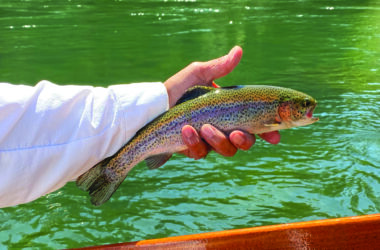“Spring runoff” is a condition that merited your consideration a few years ago. But the recent unseasonable heat wave accelerated the melting of our ample statewide snowpack, causing the rivers and streams that drain the west Cascades to spike upward to levels where the probability of a quality angling experience becomes marginal at best.
The ample spring runoff has also slowed the spring chinook run into the southern tributaries of the Willamette River. At the end of April, just before melting snow began to influence river and stream levels, migrating salmon counted at the Willamette Falls had reached over 500 on a couple of consecutive days – generally a sign that the run is “on.” But rising water levels have temporarily slowed the falls’ count to only about 100 per day. Water temperatures, integral to salmon migration, dropped into the low 50s and is no doubt a contributing factor in slowing the migration.
Less than good news, fluctuating river conditions will last into June. In the near term it will hamper mostly trout anglers on the McKenzie River and other streams that see early spring stocking. And so far only about 3,000 spring salmon have made it past the Willamette Falls. But you can expect the salmon migration to surge in the first weeks of June toward the peak of the run in early July. With numbers expected to exceed 60,000 salmon, this year’s run is predicted to be the best Willamette spring salmon migration in a couple of decades.
Let me add that summer steelhead returning to Willamette River tributaries are lagging behind last year’s “so-so” numbers by more than a thousand fish. Summer steelhead tend to be more resilient in higher and colder river conditions, so I was hopeful of higher numbers. But it’s nearly impossible to accurately predict the annual summer steelhead run size and It is still early with plenty of time to see those numbers rebound.
Conversely, lakes across our region are currently nearly full and in prime condition and trout stocking always ramps up in the spring. The ODFW through April has been busy stocking thousands and thousands of rainbow trout into still water resources all over Lane County. Also into other lakes in counties all across the Beaver State.
In addition to hatchery trout, most of Lane County lakes offer a multi-species opportunity and hold wonderful numbers of warm-water fish. Some have both large and smallmouth bass, crappie, perch and even bluegill, swimming in lakes where you can troll or bank fish for trout in the morning. Then shift to the flats, flooded timber areas and shallow bays in the afternoon, where bass and other sunfish species stage in the spring and early summer.
A snapshot of several local lakes shows conditions on lakes and reservoirs that this spring are representative of most of the state of Oregon. On Blue River Reservoir at Saddle Dam Landing, the lake level is 50 feet above the end of the ramp. At Cottage Grove Reservoir, the Lake Side boat ramp is 40 feet above the end of the ramp, and at Baker Bay on Dorena, the lake level is 60 feet above the end of the ramp. Hills Creek is also nearly full, the lake level at Packard Creek ramp is 54 above the end of the ramp.
In anticipation of additional runoff, Fall Creek Reservoir has had fluctuations ranging from five to ten feet and has not yet been dependably accessible from day to day, but should stabilize in time for the Memorial Day weekend and the beginning of the summer season. Lastly, the Dune Lakes in far western Lane County are currently experiencing conditions that have not been this good in the last five years.







